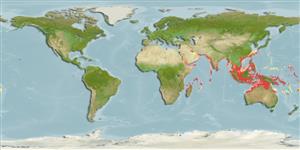Environment: milieu / climate zone / depth range / distribution range
Ecologie
marien; brak water; diepte 15 - 100 m (Ref. 30573). Tropical; 30°N - 21°S, 36°E - 178°W
Indo-West Pacific: East Africa (Ref. 2871, 5213, 30573) to Southeast Asia, north to Japan, south to Queensland, Australia. Reported from Fiji (Ref. 12743).
Lengte bij maturiteit / Grootte / Gewicht / Leeftijd
Maturity: Lm 15.0 range ? - 19.2 cm
Max length : 40.0 cm TL mannelijk / geslacht onbekend; (Ref. 2872); common length : 30.0 cm TL mannelijk / geslacht onbekend; (Ref. 2872)
Korte beschrijving
Determinatiesleutels | Morfologie | Morfometrie
Dorsale stekels (totaal) : 8 - 9; Dorsale zachte stralen (totaal) : 20 - 22; Anale stekels: 3; Anale zachte stralen: 25 - 28. Silvery grey with blue iridescence dorsally, silvery white ventrally; upper part of gill cover with a dusky black spot; fins pale yellow. Mouth large and oblique.
Found in coastal waters down to a depth of about 100 m (Ref. 30573) and between 15-90 m in western Indonesia (Ref. 12260). Feeds on sand-dwelling animals (Ref. 5213). Marketed fresh and dried salted.
Levenscyclus en paargedrag
Maturiteit | Voortplanting | Paaien | Eieren | Fecunditeit | Larven
Paxton, J.R., D.F. Hoese, G.R. Allen and J.E. Hanley, 1989. Pisces. Petromyzontidae to Carangidae. Zoological Catalogue of Australia, Vol. 7. Australian Government Publishing Service, Canberra, 665 p. (Ref. 7300)
Status op de Rode Lijst van het IUCN (Ref. 130435: Version 2024-1)
Gevaar voor de mens
Harmless
Gebruik door de mens
Visserij: commercieel
Tools
Speciale rapporten
Download XML
Internetbronnen
Estimates based on models
Preferred temperature (Ref.
123201): 25.3 - 28.6, mean 27.6 °C (based on 746 cells).
Fylogenetische diversiteitsindex (Ref.
82804): PD
50 = 1.5000 [Uniqueness, from 0.5 = low to 2.0 = high].
Bayesian length-weight: a=0.01318 (0.00948 - 0.01833), b=2.94 (2.85 - 3.03), in cm total length, based on LWR estimates for this species (Ref.
93245).
Trofisch niveau (Ref.
69278): 4.2 ±0.7 se; based on diet studies.
Weerstandsvermogen (Ref.
120179): Hoog, minimale populatieverdubbelingstijd minder dan 15 maanden (K=0.6).
Prior r = 0.75, 95% CL = 0.49 - 1.12, Based on 5 data-limited stock assessments.
Fishing Vulnerability (Ref.
59153): Low vulnerability (21 of 100).
Climate Vulnerability (Ref.
125649): High vulnerability (65 of 100).
Nutrients (Ref.
124155): Calcium = 157 [98, 292] mg/100g; Iron = 1.74 [1.04, 2.72] mg/100g; Protein = 19.2 [18.2, 20.2] %; Omega3 = 0.314 [0.186, 0.547] g/100g; Selenium = 50.3 [25.4, 103.9] μg/100g; VitaminA = 20.9 [7.9, 57.3] μg/100g; Zinc = 1.2 [0.9, 1.7] mg/100g (wet weight);
